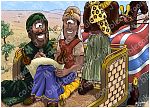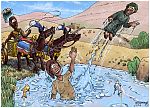Bible Cartoon: Acts 08 - Philip and the Ethiopian eunuch - Scene 04 - Baptism
Click on Add to cart button below shopping cart.
Purchased Bible Cartoons do not have watermarks. Links to Cartoons provided on email once purchase is completed.Bible Book: Acts
Bible Book Code: 4400803801
Scene no: 4 of 6
Bible Reference & Cartoon Description
Acts 8:38 (NLT)
He ordered the carriage to stop, and they went down into the water, and Philip baptized him.
DRAWING NOTES:
TIME OF DAY:
Unspecified. I’ve made it late morning.
LIGHTING NOTES:
There is a single light source for this scene: the sun, high in the sky.
CHARACTERS PRESENT:
Philip the evangelist. Ethiopian eunuch, chariot driver.
RESEARCH/ADDITIONAL NOTES:
I have chosen to show a two wheeled chariot, pulled by two horses. Admittedly it may have been a four wheeled carriage, & when you consider that Philip was invited up into it, & both the eunuch & Philip may have been looking at the scroll, it may have been more comfortable for them to have been riding in a four wheeled carriage rather than leaning against the front of a chariot & thus travelling backwards! Still, I decided to make it the classic two-wheel, two horse variety!
Notice that Philip’s outer robe & the eunuch’s outer robe & head gear are on the road side.
Notice the two Gecko’s chasing each other on the fore ground rocks. They are Sinai Fan Fingered Gecko aka Fan-footed Gecko (Ptyodactylus guttatus).
Where did the baptism take place?
My research points to a little village north of Hebron in southern Israel called Bethsur:
Jerome [1], in his Lift of Paula, testifies that a road from Jerusalem to Gaza went through Hebron. Paula travelled from Jerusalem to Bethlehem, which lay south of the city: ‘When she reached Bethlehem she quickened the pace of her horse, and took the old road which leads to Gaza. This road conducted to Bethsur (a little north of Hebron), where,’ says Jerome, while he read the Scriptures, the eunuch found the gospel fountain.’ This,’ adds Rammer, is the same Bethzur of which Jerome, in his Onomasticon, says, As you go from Elia to Hebron, at the twentieth milestone, you meet Bethsoron, near which, at the foot of a mountain, is a fountain bubbling out of the soil.
(Source: http://gluedideas.com/content-collection/cyclopedia-of-biblical-literature/Roads_P1.html)
Based on this research I decided to show the mountains of the region just north of Hebron, with a pond in the foreground, at the foot of the mountain as described above.
[1]
I think “Jerome” refers to Saint Jerome (Latin: Eusebius Sophronius Hieronymus; Greek: Εὐσέβιος Σωφρόνιος Ἱερώνυμος; c. 347 – 30 September 420)





